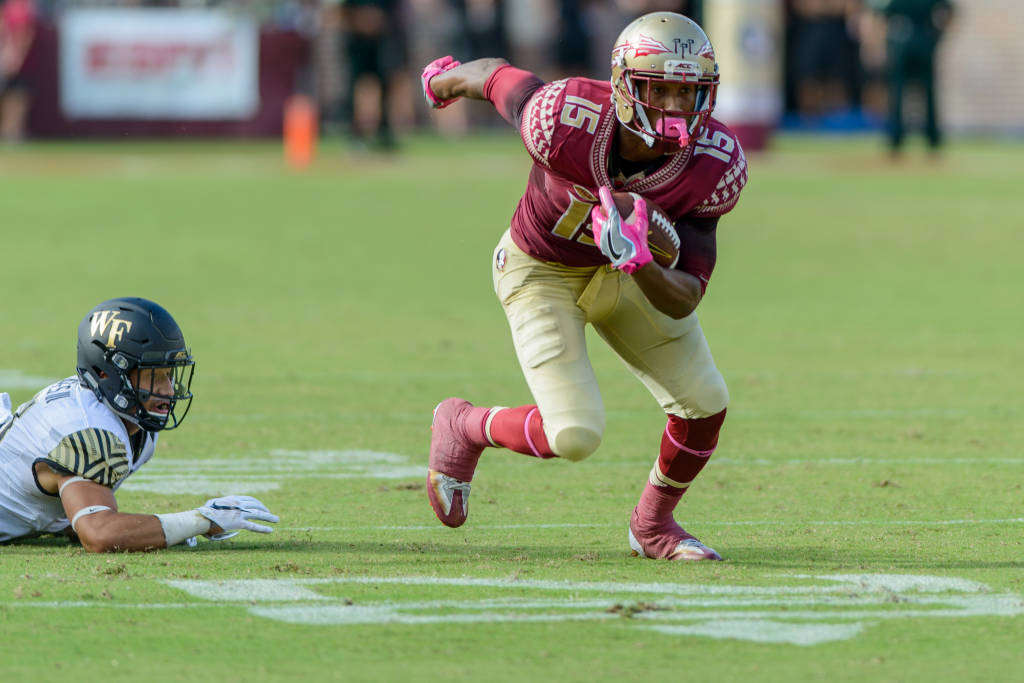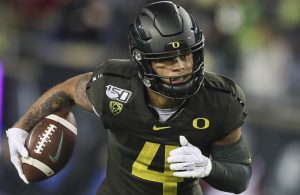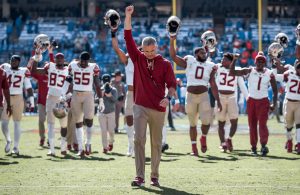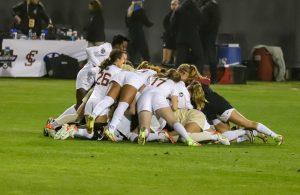- Sunday Seminole Summary: FSU Football Adds Pair of WR Transfers
- Sunday Seminole Summary: FSU Football Exits ESD With Top-15 Class
- Sunday Seminole Summary: FSU Soccer Tops BYU for Third National Championship
- Sunday Seminole Summary: FSU Soccer Advances to National Championship Match
- Seminole Sunday Summary: FSU Soccer Heads Back to College Cup
- Seminole Sunday Summary: FSU Soccer Reaches Sweet 16; Football Tops Boston College
- Seminole Sunday Summary: FSU Soccer Wins ACC, Advances to Second Round of NCAA Tournament; FSU Football Rallies Past Miami
- Seminole Sunday Summary: FSU Soccer Tops Wake on OT to Advance to ACC Final
- Seminole Sunday Summary: FSU Football Crushes UMass for Third Straight Win
- Seminole Sunday Summary: FSU Soccer Stays Perfect with Pair of Wins
Orange Bowl: Position Match-ups
- By Clint Eiland
- Updated: December 16, 2016
 Perrone Ford/FSU athletics
Perrone Ford/FSU athleticsWith just two weeks remaining before the Capital One Orange Bowl on Dec. 30, expect an uptick in preview pieces devoted to Florida State vs. Michigan. Bowl season begins soon and almost everybody (including college football writers) will be glued to their screens watching football. Besides the playoff, the contest between the Seminoles and Wolverines might garner the most views of any bowl game.
The main reason? It’s two teams with storied traditions, loads of NFL talent, and expectations that were sky high in 2016. Neither achieved those expectations, but it’s hard to be mad at a prestigious bowl selection. The unexpected benefit? Both teams will be looking to end their seasons on a high note.
With that, the positional match-ups and general comparisons will be made between the two teams. As part of our ongoing coverage all the way through the game, The Daily Nole decided to take a look at some of these intriguing battles. Below we’ve split them up into two categories: Groups that are directly against each other, and a general comparison between positional units.
FSU Offensive Line vs. Michigan Defensive Line
There might not be a more clear cut advantage than the match-up between Florida State’s offensive line and Michigan’s defensive line. The Seminoles have certainly improved as the year has progressed, culminating in a surprisingly effective performance against the Florida Gators’ line, who many thought would provide the toughest challenge yet. They responded with a 0-sack, 249-yard rushing effort and helped the team cruise to a 31-13 victory.
But even at their fullest potential, they would still have trouble with Michigan’s defensive line. Multiple sites have made the comparison between Michigan and Alabama in this regard. Ends Taco Charlton and Chris Wormley and tackles Ryan Glasgow and Maurice Hurst are all legitimate early draft picks. They’ve combined for 37 tackles for loss and and 21.5 sacks, and that’s not even including talents like Rashan Gary who rotate in. The Michigan defensive line has no weaknesses.
Now, that doesn’t mean the FSU offensive line can’t win the match-up. Think back to the Florida example, where the FSU front surpassed all expectations and gave one of its best games of the year. It’s possible that the Seminoles could shock a lot of people and hold stout against Michigan. But on paper, that is clearly a daunting prospect.
Advantage: Michigan Defensive Line
Michigan Offensive Line vs. FSU Defensive Line
The second clearest advantage? Michigan offensive line against the FSU defensive line. The Wolverines are a well-built team that has very few “weaknesses”. If there’s one part that might fit the bill, it’s the offensive line. It’s a unit that started off the year hot, but then a knee injury to starting left tackle Grant Newsome forced the Wolverines to shuffle players around. Two of their last three games against Iowa and Ohio State presented some of their most underwhelming efforts yet. Despite a shaky end to the year, they still finished high in categories like adjusted sack rate (27th) and decently in adjusted line yards (47th).
Florida State’s defensive line began the year with inconsistency, but as players like Derrick Nnadi and Josh Sweat recovered from injury, the Noles became dominant. The common starting lineup of DeMarcus Walker, Nnadi, Demarcus Christmas, and Sweat ended the year with a total 37 tackles for loss and 28 sacks. Meanwhile, true freshman Brian Burns added 9.5 sacks and was heavily used in certain situations/packages. They became arguably the best pass-rushing line in the nation.
Advantage: FSU Defensive Line
FSUÂ Receivers vs. Michigan Secondary
One of the more positive storylines for FSU this year was the development of receivers Auden Tate and Nyqwan Murray. Both entered their first year of significant playing time, with the latter attempting to reproduce the production of established receiver Jesus Wilson. They largely succeeded, with Tate becoming nearly unstoppable in the red zone. They finished with a combined 746 receiving yards and nine touchdowns. While Kermit Whitfield and Travis Rudolph had disappointing seasons, they still showed up in big games like against Florida and Miami, and provided help to new quarterback Deondre Francois.
All four will need to have their best games of the season to produce similar results against the Michigan secondary. Jabrill Peppers gets all the hype (some undeserved), but corners Jourdan Lewis and Channing Stribling have been fantastic in coverage this year. There are no easy passes on this defense, and it’s hard to see any of the Florida State’s receivers having a big night. One candidate who might? Auden Tate. You can’t teach size, and the connection he has built with Francois allows him to exploit cornerbacks who aren’t used to it.
Advantage: Michigan Secondary
Michigan Receivers vs. FSU Secondary
Not much changed between Michigan’s 2015 receivers and 2016 receivers. The Wolverines’ top three receivers remained their top three receivers: Amara Darboh (826 yards, seven touchdowns), tight end Jake Butt (518 yards, four touchdowns), and Jehu Chesson (469 yards, two touchdowns) received the large majority of receptions and yards. As in, they accounted for 68 percent of receptions and 76 percent of receiving yards. Chesson has the most speed of the three, and Florida State will need to ensure that he doesn’t get behind the safeties for a deep touchdown like he’s able to. However, Butt could have a huge game against FSU if the Seminoles lose track of him. He’s not insanely athletic, but he’s a great route-runner with fantastic receiving skills. Think of him as Nick O’Leary with a much higher ceiling.
Thankfully the Florida State secondary has recovered from a disastrous beginning. Cornerback Tarvarus McFadden struggled mightily in his first few starts, but he’s been as good as anyone down the back stretch of the schedule (eight interceptions doesn’t hurt either). Marquez White regained some of his mojo during the Clemson game and wrecked havoc on Florida in the final contest of the regular season. Derwin James might be out, but Trey Marshall did well at safety when he was healthy, and Ermon Lane, who converted from receiver midway through the year, is one of the more surprising developments of 2016.
This is a very close match-up that could go either way, depending on how well prepared the units are. It would not be surprising to see younger players for FSU like Carlos Becker or Kyle Meyers get reps in the Orange Bowl if Michigan focuses on trying to pass. The improvement down the stretch for Florida State’s secondary ultimately gives them the edge, but the Wolverines’ receiving threats are no joke. Just ask Florida what happened last year in the Citrus Bowl.
Advantage: FSU Secondary
Individual Units
Quarterback: Florida State
Deondre Francois and Wilton Speight both got their first major action in 2016. Some surface level stats might make this seem like a draw, but delving into those numbers brings the conclusion that the former had a better year. In addition to having almost 1,000 more total yards, Francois was better against tougher competition. Against S&P top 25 pass defenses, Francois had more yards per game (247 vs. 216) and a higher yards per attempt (7.54 vs. 6.72). The only area Speight was better in was touchdown passes (8 vs. 5), but our piece on him pointed out that this might be misleading.
Special Teams: Michigan
It takes a special type of year to make FSU fans pine for the days of Cason Beatty, but somehow the team achieved just that. Ricky Aguayo finished the season making 70 percent of his field goal attempts, but on kicks of 40 yards or more, he was a paltry 46 percent. There’s reasons for optimism with Aguayo, but suffice to say he’s not totally reliable as a kicker yet. Where the real issues are for FSU is in the punting game. Logan Tyler is also a true freshman, but he has not been the punter most expected him to be: he is barely averaging over 40 yards per punt, compared to the 45.2 mark of Beatty during his senior year of 2015.
Even worse, the FSU punt return coverage is ranked 127th in average yards given up per return. That is second to last in the entire FBS. It’s not like the Seminoles have done well returning punts themselves. Jesus Wilson was the starter before an injury sidelined him for the rest of the year. Prior to that injury, he had 155 yards and one touchdown on nine returns, even if a majority of those yards came against Charleston Southern. His replacement (Nyqwan Murray) has just 2 yards on 10 returns. And he fumbled a punt in the regular season finale against Florida that the Gators picked up and returned for a touchdown. FSU special teams has hurt the team so much that it might consider getting a new special teams coordinator.
That’s a long way of saying that Michigan has the advantage. Kicker Kenneth Allen has made 80 percent of his field goal attempts, with a slightly higher 50 percent on kicks of 40 yards and beyond. He also averages 42.6 yards per punt. Jabrill Peppers — while maybe not deserving of Heisman consideration — is deadly as a punt returner. Peppers averages 14.8 yards per return on 21 attempts, and housed one against Colorado. It would not be surprising to see a special teams play make the difference in this game.
Running Back: Florida State
There’s not much to say on this one. FSU junior Dalvin Cook is one of the best backs in the country and will likely be a top 20 NFL Draft pick. Jacques Patrick averages 5.8 yards per carry and rumbled his way to 348 yards on the season. Meanwhile, Michigan seems to have a running back by committee, with five players receiving 20 or more carries this season. De’Veon Smith is the main guy, who has had a decent 810 yards and 10 touchdowns on 4.8 yards per carry. The Wolverines do have more total rushing yards (2,679 vs. 2,481) and touchdowns (40 vs. 31) on the season, but they also had 55 more attempts. Florida State still has the best player on the field, so this section is its advantage.
Linebackers: Michigan
Nobody really stands out for Florida State in the linebacker position. Jacob Pugh is strong against option quarterbacks, but he plays a hybrid position. Matthew Thomas and Dontavious Jackson have done well, but that’s about all you can say about them. Michigan on the other hand has two great linebackers in Ben Gedeon and Mike McCray, who lead the team in total tackles and tackles for loss. Add in Peppers in certain schemes, and its clear that the Wolverines are set at the position.




You must be logged in to post a comment Login